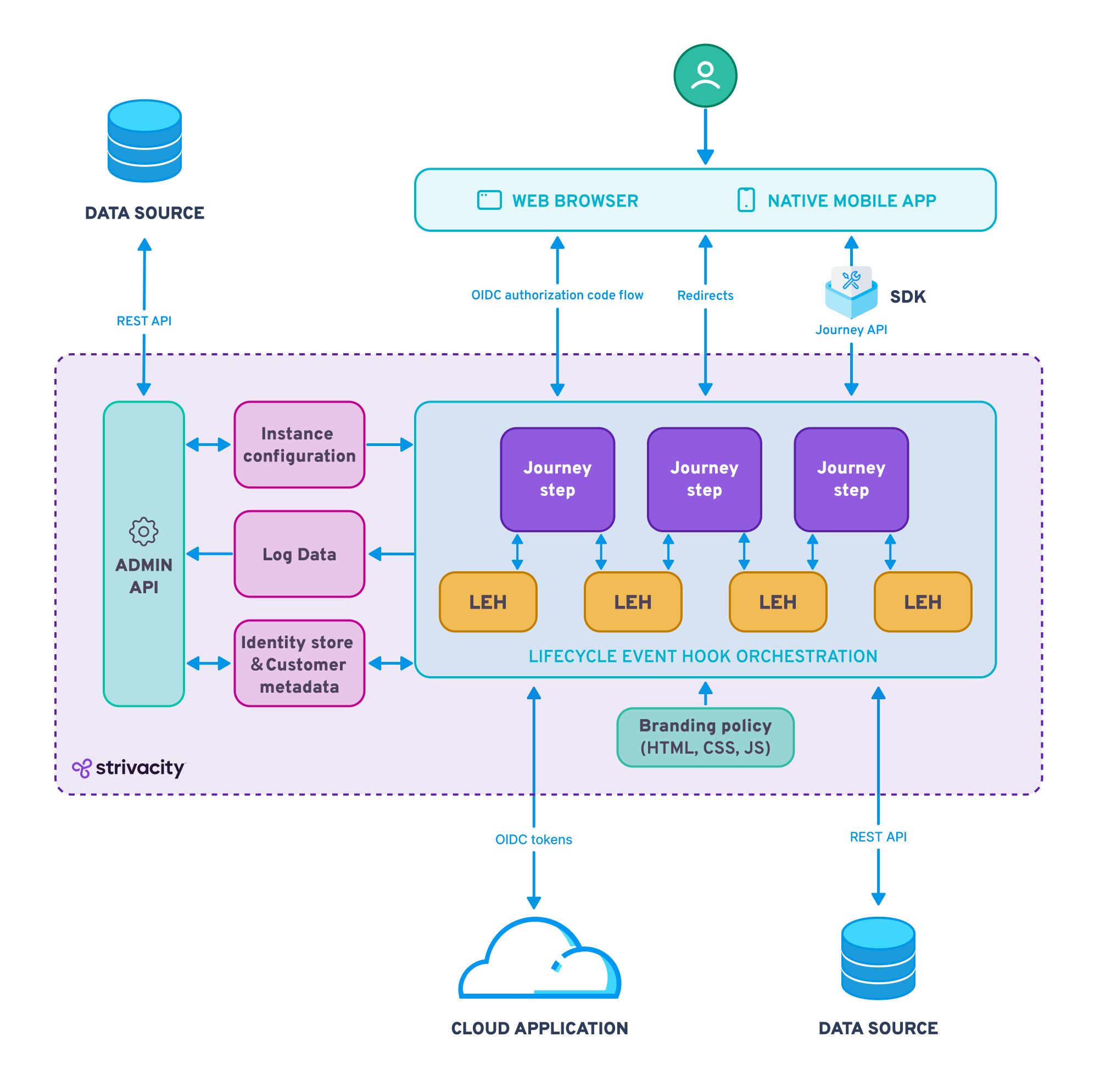Extensibility platform
Our extensibility platform can step in when you require more than pure policy-driven configuration to get sign-in and sign-up journeys just the way you want.

Strivacity’s extensibility platform is a host of serverless dev environments that allows you to securely pop in low-code configurations or customizations without needing to stand up and maintain extra infrastructure. All of your custom code is hosted on-platform using serverless architecture. With in-product IDE and code management, you can create and test integrations on the spot, in real time. No dev tickets necessary.
This approach allows for:
Flexibility Low-code solutions extend your flexibility with the product. You have the space to navigate home-grown solutions or third-party vendors of your choice.
Compatibility Strivacity has a standards-based approach—e.g. support for OAuth/OpenID and SAML— that ensures interoperability with third-party providers of your choice and keeps you out of vendor lock.
Scalability You can forget the pains of maintaining legacy systems. Strivacity’s cloud-native performance will allow you to easily update and scale as your requirements change.
Orchestration
Our extensibility platform is also the basis of our orchestration engine which provides you with limitless possibilities for expanding the product. API gateways are also available so you can easily integrate your in-house capabilities.
Lifecycle event hooks
Our flavor of orchestration, also known as journey-time orchestration allows you to embed custom business logic into customer journeys.
Creating an event hook
-
You can develop your code in an on-platform environment using JavaScript on top of node.js.
-
You can use the rich context provided about the application and customer objects, and various transaction details to pinpoint your events of interest.
-
Orchestration taps into the node package manager (NPM) ecosystem for fast implementation. Hooks can pull from more than one million available packages.
-
To make hook development even more effortless, you can pull up pre-built integrations from our plugin library. Pre-built hooks come with pre-selected event hook types and with all the necessary dependencies set up.
-
You can test and debug your hooks on the spot in a safe non-production environment before they go live.
-
Full on-platform auditing is available, making improving and debugging a cinch.
Plugin library
Event hook plugins are built for dozens of the most common applications, including Adobe, Salesforce, Hubspot, ServiceNow, Amplitude, etc., and cover 80% of orchestration use cases.
Running an event hook
Orchestration takes place between customer journey steps. You can perform a number of actions with customer data and even change customer journeys en route based on the data you've gathered:
-
You can pull in customer data from your third-party systems (e.g. CRMs or CDPs).
-
You can keep your customer data synced with third-party data sources, such as your MarTech stack or custom apps.
-
You can send conversion data to your digital analytics platform.
-
You can feed your fraud detection tools various user activities to get highly contextual alerting in case of threats.
-
You can use hooks in the back channel for secure connections to third-party APIs.
Blocking and non-blocking hooks
As you hook into journeys, hooks will perform blocking or non-blocking actions. Blocking hooks take control of the customer flow to execute an action, such as denying or allowing a sign-in request, while non-blocking hooks usually dispatch data.
Attributes extensible with JavaScript
You can steer clear of hard-coded user registration with extensible attributes that personalize your experience while keeping your forms simple. Also known as conditional form logic, this extensibility allows you to build interactive forms that adapt as customers go. This way different personas can go into a uniform flow but can take their own paths without feeling they're hitting speed bumps.
Brand policy extensible with HTML, CSS, JS
Branding extensibility features allow you to customize the presentation layer of your customer journeys way beyond the color scheme and logos of your brand.
Custom CSS
Our branding policy editor lets you add styling or import a complete stylesheet and customize layout elements down to the last bit.
Additional contents
You can display extra elements in your customer experience by applying custom HTML if the default ones are not enough.
Additional scripts
Additional scripts take adding new elements to your customer experience up a notch by allowing you to run scripts as part of your branding. You can apply your web development techniques to Strivacity-hosted applications: you can synchronize content from the rest of your domains, embed widgets, use custom fonts, or re-organize your static HTML and CSS elements as you like.
Updated 10 months ago
